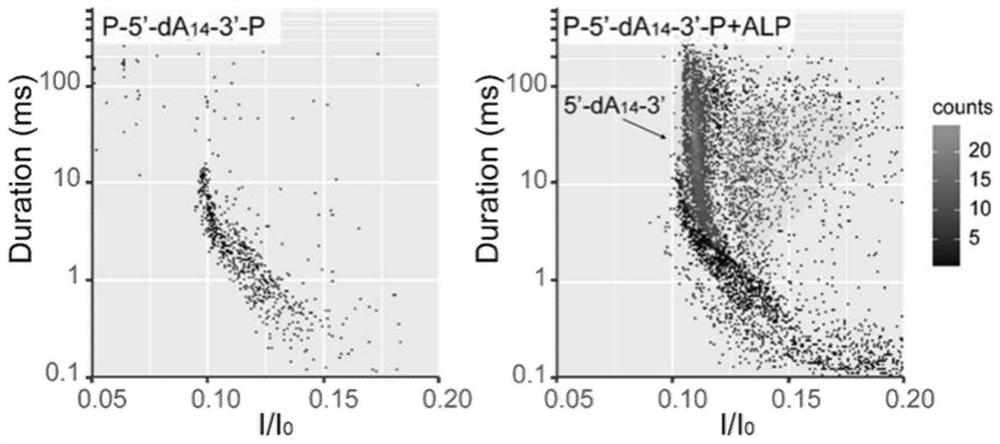Application of Aerolysin Nanopore Channels in Biophosphorylation and Related Enzyme Analysis
An Aeromonas lysin and nanopore technology, applied in the biological field, can solve the problems of weak interaction and insensitive detection of phosphorylation state, and achieve the effects of real-time monitoring, high sensitivity and convenient detection.
- Summary
- Abstract
- Description
- Claims
- Application Information
AI Technical Summary
Problems solved by technology
Method used
Image
Examples
Embodiment 1
[0046] Example 1: Detection of nucleic acid phosphorylation / dephosphorylation
[0047] (1) Construction of Aeromonas lysin nanopore channel: Assemble the detection cell and add pH=8 electrolyte solution (Tris buffer, 1 mol / L) at both ends of the detection cell, and 50 μm micropores on the detection cell A phospholipid bilayer is constructed at the phospholipid bilayer, and aeromonasin is added to one end of the detection cell, and the aerolysin nanopores are formed on the phospholipid bilayer;
[0048] (2) Apply a voltage of 300mV at both ends of the Aeromonas lysin nanopore channel, and add 10ul of the substance to be tested (the amount to be added is determined according to the detection requirements, generally 1-100uL) into one end of the detection cell (Cis end), Driven by the potential, the analyte passes through the Aeromonas lysin nanopore to generate the blocking current signal and the blocking current time;
[0049] (3) Compare and analyze the blocking current signal...
Embodiment 2
[0053] Example 2: Detection of alkaline phosphatase
[0054] (1) Construction of Aeromonas lysin nanopore channel: Assemble the detection cell and add MgCl containing MgCl to both ends 2 pH=7.5 electrolyte solution (Tris buffer, 1mol / L), MgCl 2 The concentration of 20mmol / L, build a phospholipid bilayer at the 50μm micropore in the detection cell, add Aeromonasin at one end of the detection cell, and wait for it to form Aeromonasin on the phospholipid bilayer. nanopore;
[0055] (2) Apply a voltage of 100 mV to both ends of the Aeromonas lysin nanopore channel, add 10 ul of the analyte to one end (Cis end) of the detection cell, and drive the analyte to pass through the Aeromonas lysin under the driving of the potential. Primitive nanopores generate blocking current signals;
[0056] (3) Compare and analyze the blocking current signal and the blocking current time to obtain the corresponding detection information of the object to be tested.
[0057] Described analyte is re...
Embodiment 3
[0060] Example 3: Detection of Polypeptide Phosphorylation
[0061] (1) Construction of Aeromonas lysin nanopore channel: Assemble the detection cell and add MgCl containing MgCl to both ends 2 pH=7.5 electrolyte solution (Tris buffer, 1mol / L), MgCl 2 The concentration of 20 mmol / L, build a phospholipid bilayer at the 50μm micropore in the detection cell, add Aeromonasin at one end of the detection cell, and wait for it to form Aeromonasin on the phospholipid bilayer. nanopore;
[0062](2) Apply a voltage of 300mV at both ends of the nanochannel, add 10ul of the analyte to one end (Cis end) of the detection cell, and under the drive of the potential, the analyte passes through the Aeromonas lysin nanopore to generate a blocking current Signal and blocking current time.
[0063] (3) Compare and analyze the blocking current signal and the blocking current time, and obtain the corresponding detection information of the object to be tested.
[0064] The analyte uses LRRASLG as...
PUM
| Property | Measurement | Unit |
|---|---|---|
| molecular weight | aaaaa | aaaaa |
Abstract
Description
Claims
Application Information
 Login to View More
Login to View More - R&D
- Intellectual Property
- Life Sciences
- Materials
- Tech Scout
- Unparalleled Data Quality
- Higher Quality Content
- 60% Fewer Hallucinations
Browse by: Latest US Patents, China's latest patents, Technical Efficacy Thesaurus, Application Domain, Technology Topic, Popular Technical Reports.
© 2025 PatSnap. All rights reserved.Legal|Privacy policy|Modern Slavery Act Transparency Statement|Sitemap|About US| Contact US: help@patsnap.com



